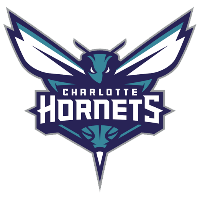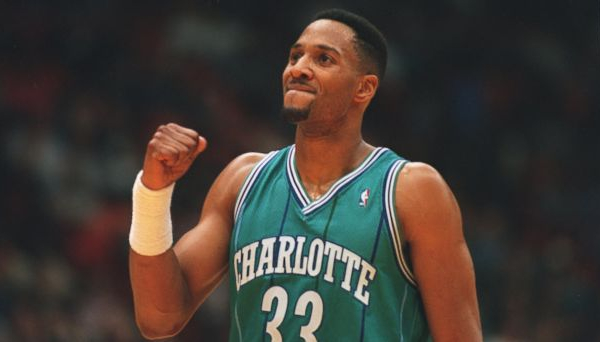
Charlotte Hornets

1988 Charlotte
When the NBA announced in 1985 that it was considering a four-franchise expansion, North Carolina businessman George Shinn announced his intention to create a franchise based in Charlotte.
In that state, college basketball, the same basketball that would lead Michael Jordan to glory years later, was a highlight. But even with this starting point, it didn't seem possible that this small city could sustain a franchise of NBA stature.
Early years
Shinn, seeing the skepticism, had a surprise in store, the Charlotte Coliseum, a pavilion that would hold 24,000 spectators, thus becoming the largest capacity pavilion in the history of the league. On April 5, 1987, Commissioner David Stern informed Shinn that his project was officially an NBA franchise, coming into the competition alongside the Heat, Timberwolves and Magic.
They were originally called the Charlotte Spirit, but in a contest held to name the team, the Hornets, a common sports name in this city, won. Once the name was chosen, they chose their colors, the aquamarine green, which would later become a fashion statement in the 1990s.
North Carolina poured its heart and soul into the Hornets throughout the franchise's first season, selling 21,000 tickets. They hung the ''sold out'' sign for 358 consecutive games, which made Shinn proud. He hired Carl Scheer as general manager, who decided to build a veteran team, hoping to make the playoffs in five years.
Led by former Pistons forward Kelly Tripucka, the Hornets got off to a rough start in the 1988-89 season. They also had rookie Rex Chapman, Muggsy Bogues, and veteran Kurt Rambis, who had won a ring with the Lakers in previous years, and averaged 104.5 points for and 113 against that season. They suffered 62 losses without winning more than two consecutive games.
The following season did not improve much. The players rebelled against Harter, the coach, being replaced by assistant Gene Littles. But the change made them add one more loss, 63, without being able to lift their heads, with a 3-31 record in January, which made them give up the season since the beginning of 1990. In that year's draft, they selected Kendall Gill to strengthen the franchise and lay the foundation for success, but failed to make the playoffs.
Larry Johnson arrived in the 1991-92 season, and won the Rookie of the Year, helping in a key victory that year, a 132-115 win over the Golden State Warriors. They had playoff aspirations, but lost their last five games, falling out of the playoffs with a record of 31 wins to 51 losses.
Chance for victories
In the 1992-93 season, the Hornets began to raise their heads. That season Alonzo Mourning was drafted , who along with sophomore Johnson, would form a duo of 20-10 players. The second-year player was a starter in the 1993 All-Star game, and the rookie eliminated the Celtics in the first round of the playoffs with a basket at the buzzer, the first year they had made the playoffs. Although they had desire and talent, they did not have enough experience, being eliminated by the Knicks in the Conference Semifinals.
The following year was marked by the absence, due to injuries, of Johnson and Mourning. That season closed with a 41-41 insufficient to reach the playoffs.
They reached the playoffs in 1994-95 with their first 50-win season, but were eliminated by Jordan's Bulls. At the beginning of that season, Celtics veteran Robert Parish joined the Hornets. In turn, Mourning and Johnson played in the 1995 All-Star game. After many roster changes, Charlotte failed to return to the playoffs in the 1995-96 season.
Mistakes,playoffs and last years as Hornets
In the 1996 Draft, while picking Kobe Bryant, he was sent to the Lakers in exchange for Vlade Divac. Along with Mason and Rice, they led a Hornets hungry for revenge. Rice won the All-Star MVP, and led the team to 54 regular season wins. All these efforts combined, nothing was enough for the Knicks to knock them out in the first round.
The following season was also rich in success. The team signed David Wesley and Bobby Phils, who, added to the previous year's squad, reached 51 wins, even finishing for the second time in the Conference Semifinals, eliminated again by the Bulls. The following year, as a result of roster changes, they did not make the playoffs, marking the beginning of their decline.
In the 1999-00 season, they suffered a hard blow to their bench. Bobby Phills died in a traffic accident, and the Hornets retired his jersey less than a month later. With his memory in their minds, they returned to the playoffs, eliminated in the first round by the 76ers.
Even making the playoffs, the following season was overshadowed by some very harsh and reprehensible headlines. Shinn, after breaking off negotiations with Michael Jordan to become a co-owner, saw his name in the papers following a lawsuit by his wife for rape . The city's reputation plummeted in the wake of this sexist scandal. Meanwhile, the team lost in the Conference Semifinals to the Bucks.
In 2002, the Hornets were one of the clear favorites to win the ring, thanks to the explosion of Mashburn, but in the first 10 minutes of the first playoff game, he had to retire due to a viral illness. As during the regular season, also marked by Mashburn's absences, Davis led the team, which fell, again, in the Conference Semifinals, to Jason Kidd's Nets.
Shinn was slowly beginning to reject the Charlotte Coliseum, and broke the news that another pavilion would be built, or the Hornets would leave town. Although the city initially refused, what would become the Charlotte Bobcats Arena was eventually built, so the owner withdrew his request to move the franchise.
But, against all odds, they ended up moving to New Orleans in the 2003-02 season, making a new team for North Carolina. Several ownership groups, including Larry Bird, bid for the team, which fell into the hands of Robert L. Johnson. In June 2006, Michael Jordan became the franchise's second largest shareholder. The name Bobcats, or Red Lynx, was chosen, and thus began the new basketball journey in Charlotte.
Birth of the Bobcats
Bernie Bickerstaff would be the coach of the young Bobcats, who led an expansion draft by selecting young players such as Gerald Wallace, Jason Kapono and Primoz Brezec. They also picked up the quickly traded Sasha Pavlovic and Zaza Pachulia, and in the 2004 Draft they selected Emeka Okafor, who would end up winning Rookie of the Year in 2005. They had a solid team, but managed no more than 18 wins that season.
They managed 26 wins the following season, having acquired Raymon Felton and Sean May in the 2005 Draft, who joined an already solid team led by Wallace, Knight, Brezec and Rush. The subsequent arrivals of Adam Morrison in 2006, and Jason Richardson in 2007 marked a new direction for the franchise, or at least tried to, as they finished a disastrous 32-50 in the 2007-08 season.
The Bobcats did not improve on the name the Hornets left in Charlotte, so Jordan decided to hire Larry Brown on the bench, considered one of the best coaches in history. In addition, they drafted D.J. Augustin and Alexis Ajinça. In the 2008-09 market, the team traded Richardson and Dudley, along with a second-round draft pick, to the Suns in exchange for Boris Diaw, Raja Bell and Seam Singletary. They fit the defensive crusade Brown wanted to pursue, but yet another move was made. To Dallas went Carroll and Hollins in exchange for DeSagana Diop.
With 35 wins and still in the playoffs, they looked good. But that summer, their starting point guard, Raymond Felton, became a free agent, which meant a serious problem for the Bobcats.
They traded Emeka Okafor, but in the summer of 2009 Gerald Henderson, Tyson Chandler, Stephen Jackson and Acie Law arrived, these two arrived thanks to the departures of Raja Bell and Vladimir Radmanovic.
In April 2010 came the big news, the best player in history, Michael Jordan, bought the team. Now he owned an NBA franchise, he was his own boss.
The rise and fall of Jordan's Bobcats
The Bobcats finished that year with a 44-38 record, reaching the playoffs for the first time, with Gerald Wallace becoming the first player of the franchise to play in the All-Star game. Despite the victories, they fell in the first round to a 4-0 Orlando Magic.
Although the following season seemed to be ready to give them great achievements, everything was frustrated little by little, and by the end of 2010 the defeats doubled the victories. Jordan communicated a change in the bench, the new coach would be Paul Silas. A trade game ended with Gerald Wallace in Portland, and a 34-48 overall record for the Bobcats.
Gone were Stephen Jackson and Shaun Livingston, in came Corey Maggete, Kemba Walker, Bismack Biyombo, Reggie Williams, Derrick Brown and Byron Mullens. In the 2011-12 season, the Bobcats broke a record, yes, but a shameful record. The worst record in league history, a 7-59 record for Charlotte.
The last two seasons as Bobcats didn't get any better. They started 2012-13 with a 7-5 record, although 6 of those wins were by a difference of four or fewer points. They then continued in their usual vein with 18 straight losses, finishing 21-61. The next season ended with a 43-39 record, but they were swept out of the playoffs in the first round by Miami.
Hornets return, but not the wins
On May 21, 2013, Jordan announced that he had requested to change the name of the franchise to the Charlotte Hornets, with the request being approved by the NBA on July 18, 2013, validating the change for the end of the 2013-14 season.
A year after the franchise owner's announcement, the Bobcats became the return of the Hornets, and in New Orleans, the Hornets became the Pelicans. With extensive turnover in the ranks, they finished with a 33-49 record in the Hornets' first season.
After acquiring Nicolas Batum, Jeremy Lamb and Jeremy Lin, they went 48-34 the following season, getting Charlotte back to the playoffs, only to lose to the Heat again, taking them to seven games in the first round. The following season, with Kemba Walker being an All-Star reserve, the Hornets finished 36-46.
The start of the 2017-18 season, they again selected Walker to the All-Star team, James Borrego came in as coach, and the franchise posted the same record as the previous season, a 36-46 .
In July 2018, Tony Parker signed with the Hornets, in Kemba Walker's final season with the Hornets. The following summer, Walker left for the Celtics, leaving the franchise without a clear leader, and no playoff hopes in the season marked by COVID-19.




































